
List of Fairbanks-Morse locomotives
Encyclopedia
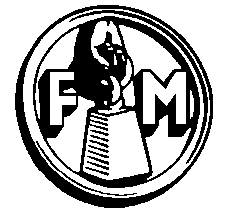
Fairbanks-Morse
Fairbanks Morse and Company was a manufacturing company in the late 19th and early 20th century. Originally a weighing scale manufacturer, it later diversified into pumps, engines, windmills, locomotives and industrial supplies until it was merged in 1958...
, is a historic American
United States
The United States of America is a federal constitutional republic comprising fifty states and a federal district...
(and Canadian) industrial scale
Weighing scale
A weighing scale is a measuring instrument for determining the weight or mass of an object. A spring scale measures weight by the distance a spring deflects under its load...
manufacturer. It later diversified into pump
Pump
A pump is a device used to move fluids, such as liquids, gases or slurries.A pump displaces a volume by physical or mechanical action. Pumps fall into three major groups: direct lift, displacement, and gravity pumps...
s, engines and industrial supplies. One arm of the company is now a diesel engine
Diesel engine
A diesel engine is an internal combustion engine that uses the heat of compression to initiate ignition to burn the fuel, which is injected into the combustion chamber...
manufacturer located in Beloit, Wisconsin
Beloit, Wisconsin
Beloit is a city in Rock County, Wisconsin, United States. As of the 2010 census, Beloit had a population of 36,966. The greater Beloit area is home to more than 91,000 residents.-Claim to fame:...
and has specialized in the manufacture of opposed piston diesel engines
Opposed piston engine
An opposed-piston engine is a reciprocating internal combustion engine in which each cylinder has a piston at both ends, and no cylinder head.-Configurations:...
for United States Naval
United States Navy
The United States Navy is the naval warfare service branch of the United States Armed Forces and one of the seven uniformed services of the United States. The U.S. Navy is the largest in the world; its battle fleet tonnage is greater than that of the next 13 largest navies combined. The U.S...
vessels and railroad locomotives since 1932. The diesel railroad locomotives the company produced are as follows:
Cab units
| Model | Build year | Total produced | Wheel arrangement AAR wheel arrangement The AAR wheel arrangement system is a method of classifying locomotive wheel arrangements that was developed by the Association of American Railroads. It is essentially a simplification of the European UIC classification, and it is widely used in North America to describe diesel and electric... | Prime mover Prime mover (locomotive) In engineering, a prime mover is an engine that converts fuel to useful work. In locomotives, the prime mover is thus the source of power for its propulsion. The term is generally used when discussing any locomotive powered by an internal combustion engine... | Power output Horsepower Horsepower is the name of several units of measurement of power. The most common definitions equal between 735.5 and 750 watts.Horsepower was originally defined to compare the output of steam engines with the power of draft horses in continuous operation. The unit was widely adopted to measure the... | FM Erie-built FM Erie-built The Erie-built was the first streamlined, cab-equipped dual service diesel locomotive built by Fairbanks-Morse, introduced as direct competition to such models as the ALCO PA and EMD E-unit... | 1945–1949 | 82 A unit A unit An A unit, in railroad terminology, is a locomotive equipped with a driving cab, or crew compartment, and the control system to control other locomotives in a multiple unit, and therefore able to be the lead unit in a consist of several locomotives controlled from a single position... s 29 B unit B unit A "B" unit, in railroad terminology, is a locomotive unit which does not have a driving cab, or crew compartment, and must therefore be controlled from another, coupled locomotive with a driving cab . The term booster unit is also used. The concept was largely confined to North America... s |
A1A-A1A | FM 38D-10 opposed piston |
2000 hp |
|---|---|---|---|---|---|---|
| FM OP800 FM OP800 The OP800 was a lightweight, streamlined railcar built by the St. Louis Car Company in 1939. Fairbanks-Morse supplied the 800 hp, five-cylinder 8 x 10 opposed piston engine prime mover. The units were configured in a highly-unusual 2-A1A wheel arrangement mounted atop a pair of road trucks, and... |
1939 | 6 | A1A-2 | FM 38D-5 opposed piston Opposed piston engine An opposed-piston engine is a reciprocating internal combustion engine in which each cylinder has a piston at both ends, and no cylinder head.-Configurations:... |
800 hp | 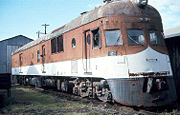 |
| FM P-12-42 FM P-12-42 The P-12-42, also known as the Speed Merchant, was a streamlined, locomotive built between 1957–1958 by Fairbanks-Morse, specifically to operate on each end of the Talgo train produced by American Car and Foundry... |
1957–1958 | 4 | B-2 | FM 38D-8 Opposed piston Opposed piston engine An opposed-piston engine is a reciprocating internal combustion engine in which each cylinder has a piston at both ends, and no cylinder head.-Configurations:... |
1200 hp |  |
C-liners
| Model | Wheel arrangement AAR wheel arrangement The AAR wheel arrangement system is a method of classifying locomotive wheel arrangements that was developed by the Association of American Railroads. It is essentially a simplification of the European UIC classification, and it is widely used in North America to describe diesel and electric... | Prime mover Prime mover (locomotive) In engineering, a prime mover is an engine that converts fuel to useful work. In locomotives, the prime mover is thus the source of power for its propulsion. The term is generally used when discussing any locomotive powered by an internal combustion engine... | Power output Horsepower Horsepower is the name of several units of measurement of power. The most common definitions equal between 735.5 and 750 watts.Horsepower was originally defined to compare the output of steam engines with the power of draft horses in continuous operation. The unit was widely adopted to measure the... | FM CFA-16-4 FM Consolidated line The Consolidated line, or C-line, was a series of diesel-electric railway locomotive designs produced by Fairbanks-Morse and its Canadian licensee, the Canadian Locomotive Company. Individual locomotives in this series were commonly referred to as “C-liners”... | 1950–1953 | 36 | B-B | FM 38D-8 opposed piston Opposed piston engine An opposed-piston engine is a reciprocating internal combustion engine in which each cylinder has a piston at both ends, and no cylinder head.-Configurations:... |
1600 hp |
|---|---|---|---|---|---|---|
| FM CFB-16-4 FM Consolidated line The Consolidated line, or C-line, was a series of diesel-electric railway locomotive designs produced by Fairbanks-Morse and its Canadian licensee, the Canadian Locomotive Company. Individual locomotives in this series were commonly referred to as “C-liners”... |
1950–1953 | 18 | B-B | FM 38D-8 opposed piston Opposed piston engine An opposed-piston engine is a reciprocating internal combustion engine in which each cylinder has a piston at both ends, and no cylinder head.-Configurations:... |
1600 hp | |
| FM CFA-20-4 FM Consolidated line The Consolidated line, or C-line, was a series of diesel-electric railway locomotive designs produced by Fairbanks-Morse and its Canadian licensee, the Canadian Locomotive Company. Individual locomotives in this series were commonly referred to as “C-liners”... |
1950–1953 | 12 | B-B | FM 38D-10 opposed piston Opposed piston engine An opposed-piston engine is a reciprocating internal combustion engine in which each cylinder has a piston at both ends, and no cylinder head.-Configurations:... |
2000 hp | |
| FM CFB-20-4 FM Consolidated line The Consolidated line, or C-line, was a series of diesel-electric railway locomotive designs produced by Fairbanks-Morse and its Canadian licensee, the Canadian Locomotive Company. Individual locomotives in this series were commonly referred to as “C-liners”... |
1950–1953 | 3 | B-B | FM 38D-10 opposed piston Opposed piston engine An opposed-piston engine is a reciprocating internal combustion engine in which each cylinder has a piston at both ends, and no cylinder head.-Configurations:... |
2000 hp | |
| FM CPA-20-5 FM Consolidated line The Consolidated line, or C-line, was a series of diesel-electric railway locomotive designs produced by Fairbanks-Morse and its Canadian licensee, the Canadian Locomotive Company. Individual locomotives in this series were commonly referred to as “C-liners”... |
1950–1953 | 8 | B-A1A | FM 38D-10 opposed piston Opposed piston engine An opposed-piston engine is a reciprocating internal combustion engine in which each cylinder has a piston at both ends, and no cylinder head.-Configurations:... |
2000 hp | |
| FM CPA-24-5 FM Consolidated line The Consolidated line, or C-line, was a series of diesel-electric railway locomotive designs produced by Fairbanks-Morse and its Canadian licensee, the Canadian Locomotive Company. Individual locomotives in this series were commonly referred to as “C-liners”... |
1950–1953 | 22 | B-A1A | FM 38D-12 opposed piston Opposed piston engine An opposed-piston engine is a reciprocating internal combustion engine in which each cylinder has a piston at both ends, and no cylinder head.-Configurations:... |
2400 hp | |
| Model | Wheel arrangement AAR wheel arrangement The AAR wheel arrangement system is a method of classifying locomotive wheel arrangements that was developed by the Association of American Railroads. It is essentially a simplification of the European UIC classification, and it is widely used in North America to describe diesel and electric... | Prime mover Prime mover (locomotive) In engineering, a prime mover is an engine that converts fuel to useful work. In locomotives, the prime mover is thus the source of power for its propulsion. The term is generally used when discussing any locomotive powered by an internal combustion engine... | Power output Horsepower Horsepower is the name of several units of measurement of power. The most common definitions equal between 735.5 and 750 watts.Horsepower was originally defined to compare the output of steam engines with the power of draft horses in continuous operation. The unit was widely adopted to measure the... | CLC CPA-16-4 FM Consolidated line The Consolidated line, or C-line, was a series of diesel-electric railway locomotive designs produced by Fairbanks-Morse and its Canadian licensee, the Canadian Locomotive Company. Individual locomotives in this series were commonly referred to as “C-liners”... | 1950–1954 | 39 | B-B | FM 38D-8 opposed piston Opposed piston engine An opposed-piston engine is a reciprocating internal combustion engine in which each cylinder has a piston at both ends, and no cylinder head.-Configurations:... |
1600 hp |
|---|---|---|---|---|---|---|
| CLC CFB-16-4 FM Consolidated line The Consolidated line, or C-line, was a series of diesel-electric railway locomotive designs produced by Fairbanks-Morse and its Canadian licensee, the Canadian Locomotive Company. Individual locomotives in this series were commonly referred to as “C-liners”... |
1950–1954 | 15 | B-B | FM 38D-8 opposed piston Opposed piston engine An opposed-piston engine is a reciprocating internal combustion engine in which each cylinder has a piston at both ends, and no cylinder head.-Configurations:... |
1600 hp | |
| CLC CPA-16-5 FM Consolidated line The Consolidated line, or C-line, was a series of diesel-electric railway locomotive designs produced by Fairbanks-Morse and its Canadian licensee, the Canadian Locomotive Company. Individual locomotives in this series were commonly referred to as “C-liners”... |
1950–1954 | 6 | B-A1A | FM 38D-8 opposed piston Opposed piston engine An opposed-piston engine is a reciprocating internal combustion engine in which each cylinder has a piston at both ends, and no cylinder head.-Configurations:... |
1600 hp | |
| CLC CFB-16-5 FM Consolidated line The Consolidated line, or C-line, was a series of diesel-electric railway locomotive designs produced by Fairbanks-Morse and its Canadian licensee, the Canadian Locomotive Company. Individual locomotives in this series were commonly referred to as “C-liners”... |
1950–1954 | 6 | B-A1A | FM 38D-8 opposed piston Opposed piston engine An opposed-piston engine is a reciprocating internal combustion engine in which each cylinder has a piston at both ends, and no cylinder head.-Configurations:... |
1600 hp | |
Switchers
| Model | Build year | Total produced | Wheel arrangement AAR wheel arrangement The AAR wheel arrangement system is a method of classifying locomotive wheel arrangements that was developed by the Association of American Railroads. It is essentially a simplification of the European UIC classification, and it is widely used in North America to describe diesel and electric... | Prime mover Prime mover (locomotive) In engineering, a prime mover is an engine that converts fuel to useful work. In locomotives, the prime mover is thus the source of power for its propulsion. The term is generally used when discussing any locomotive powered by an internal combustion engine... | Power output Horsepower Horsepower is the name of several units of measurement of power. The most common definitions equal between 735.5 and 750 watts.Horsepower was originally defined to compare the output of steam engines with the power of draft horses in continuous operation. The unit was widely adopted to measure the... | FM H-10-44 FM H-10-44 The FM H-10-44 was a yard switcher produced by Fairbanks-Morse from August, 1944–March, 1950. The units featured a , six-cylinder opposed piston engine prime mover, and were configured in a B-B wheel arrangement mounted atop a pair of two-axle AAR Type-A switcher trucks, with all axles powered... | 1944–1950 | 195 | B-B | FM 38D-6 opposed piston Opposed piston engine An opposed-piston engine is a reciprocating internal combustion engine in which each cylinder has a piston at both ends, and no cylinder head.-Configurations:... |
1000 hp | 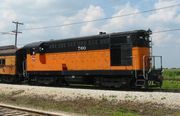 |
|---|---|---|---|---|---|---|
| FM H-12-44 FM H-12-44 The FM H-12-44 was a yard switcher produced by Fairbanks-Morse from May, 1950–March, 1961. The units featured a , six-cylinder opposed piston engine prime mover, and were configured in a B-B wheel arrangement mounted atop a pair of two-axle AAR Type-A switcher trucks, with all axles powered and... |
1950–1961 | 334 | B-B | FM 38D-6 opposed piston Opposed piston engine An opposed-piston engine is a reciprocating internal combustion engine in which each cylinder has a piston at both ends, and no cylinder head.-Configurations:... |
1200 hp | |
| FM H-12-44TS FM H-12-44TS The FM H-12-44TS was a light road switcher version of the Fairbanks-Morse H-12-44 yard switcher. Only three of the , six-cylinder opposed piston engine locomotives were manufactured especially for the Atchison, Topeka and Santa Fe Railway in May, 1956... |
1956 | 3 | B-B | FM 38D-6 opposed piston Opposed piston engine An opposed-piston engine is a reciprocating internal combustion engine in which each cylinder has a piston at both ends, and no cylinder head.-Configurations:... |
1200 hp | |
| Model | Build year | Total produced | Wheel arrangement AAR wheel arrangement The AAR wheel arrangement system is a method of classifying locomotive wheel arrangements that was developed by the Association of American Railroads. It is essentially a simplification of the European UIC classification, and it is widely used in North America to describe diesel and electric... | Prime mover Prime mover (locomotive) In engineering, a prime mover is an engine that converts fuel to useful work. In locomotives, the prime mover is thus the source of power for its propulsion. The term is generally used when discussing any locomotive powered by an internal combustion engine... | Power output Horsepower Horsepower is the name of several units of measurement of power. The most common definitions equal between 735.5 and 750 watts.Horsepower was originally defined to compare the output of steam engines with the power of draft horses in continuous operation. The unit was widely adopted to measure the... | FM H-12-46 FM H-12-46 The FM H-12-46 was a light road switcher of Fairbanks-Morse design manufactured exclusively by the Canadian Locomotive Company from October, 1951–January, 1953 for the Canadian National Railway. Only thirty of the 1,200 hp, six-cylinder opposed piston engine locomotives were produced... | 1951–1953 | 30 | A1A-A1A | FM 38D-6 opposed piston Opposed piston engine An opposed-piston engine is a reciprocating internal combustion engine in which each cylinder has a piston at both ends, and no cylinder head.-Configurations:... |
1200 hp |
|---|
Road Switchers
| Model | Build year | Total produced | Wheel arrangement AAR wheel arrangement The AAR wheel arrangement system is a method of classifying locomotive wheel arrangements that was developed by the Association of American Railroads. It is essentially a simplification of the European UIC classification, and it is widely used in North America to describe diesel and electric... | Prime mover Prime mover (locomotive) In engineering, a prime mover is an engine that converts fuel to useful work. In locomotives, the prime mover is thus the source of power for its propulsion. The term is generally used when discussing any locomotive powered by an internal combustion engine... | Power output Horsepower Horsepower is the name of several units of measurement of power. The most common definitions equal between 735.5 and 750 watts.Horsepower was originally defined to compare the output of steam engines with the power of draft horses in continuous operation. The unit was widely adopted to measure the... | FM H-15-44 FM H-15-44 The FM H-15-44 was a road switcher manufactured by Fairbanks-Morse from September 1947 to June 1950. The locomotive was powered by a , eight-cylinder opposed piston engine as its prime mover, and was configured in a B-B wheel arrangement mounted atop a pair of two-axle AAR Type-B road trucks with... | 1947–1950 | 35 | FM 38D-8 opposed piston Opposed piston engine An opposed-piston engine is a reciprocating internal combustion engine in which each cylinder has a piston at both ends, and no cylinder head.-Configurations:... |
1500 hp |
|---|---|---|---|---|---|---|
| FM H-16-44 FM H-16-44 The FM H-16-44 was a road switcher produced by Fairbanks-Morse from April 1950 – February 1963. The locomotive shared an identical platform and carbody with the predecessor Model FM H-15-44 , and were equipped with the same eight-cylinder opposed piston engine that had been... |
1950–1963 | 299 | B-B | FM 38D-8 opposed piston Opposed piston engine An opposed-piston engine is a reciprocating internal combustion engine in which each cylinder has a piston at both ends, and no cylinder head.-Configurations:... |
1500 hp | 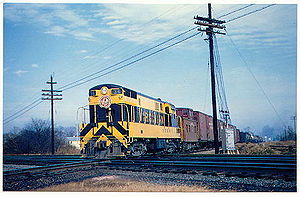 |
| FM H-20-44 FM H-20-44 The FM H-20-44 was an multiple unit-capable end cab road switcher manufactured by Fairbanks-Morse from June 1947 – March 1954, and represented the company's first foray into the road switcher market. The , ten-cylinder opposed piston engine locomotive was referred to by F-M's engineering... |
1947–1954 | 96 | B-B | FM 38D-10 opposed piston Opposed piston engine An opposed-piston engine is a reciprocating internal combustion engine in which each cylinder has a piston at both ends, and no cylinder head.-Configurations:... |
2000 hp |  |
| FM H-16-66 FM H-16-66 -External links:* *... (“Baby Train Master”) |
1951–1958 | 59 | C-C | FM 38D-8 opposed piston Opposed piston engine An opposed-piston engine is a reciprocating internal combustion engine in which each cylinder has a piston at both ends, and no cylinder head.-Configurations:... |
1600 hp | |
| FM H-24-66 FM H-24-66 -External links:* * * *... (Train Master) |
1951–1958 | 107 | C-C | FM 38D-12 opposed piston Opposed piston engine An opposed-piston engine is a reciprocating internal combustion engine in which each cylinder has a piston at both ends, and no cylinder head.-Configurations:... |
2400 hp | 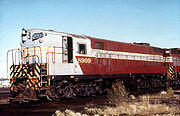 |
See also
- Opposed piston engineOpposed piston engineAn opposed-piston engine is a reciprocating internal combustion engine in which each cylinder has a piston at both ends, and no cylinder head.-Configurations:...

